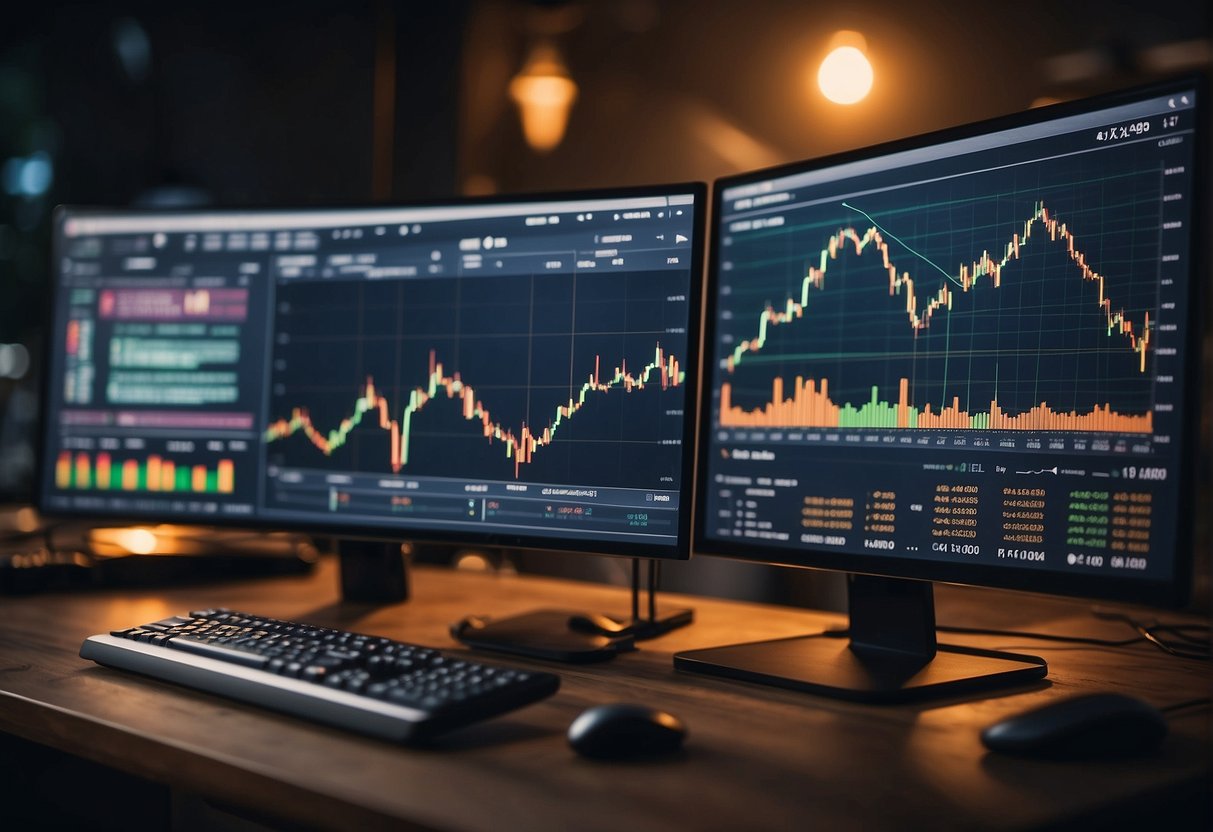Cryptocurrency trading has become increasingly popular, enabling traders to capitalize on market fluctuations and diversify their investment portfolios. Before beginning to trade, it is essential to understand a range of factors that can impact both short-term and long-term potential returns. These factors can help traders make more informed decisions, manage risks, and identify opportunities in the ever-evolving crypto landscape.

Understanding the principles of cryptocurrencies and the underlying blockchain technology is imperative for any trader. Additionally, assessing market dynamics, evaluating trading platforms, and analyzing individual investment goals are crucial to a successful trading strategy. Furthermore, it is essential to research each cryptocurrency and consider security, tokenomics, and the legal and regulatory environment.
Key Takeaways
- Familiarize yourself with cryptocurrency basics and blockchain technology to develop a solid trading foundation.
- Research trading platforms, market dynamics, and investment goals to craft a well-informed strategy.
- Examine tokenomics, security, and the legal environment to mitigate risks and identify opportunities.
Understanding Cryptocurrency Basics
Before selecting cryptocurrencies for trading, it is crucial to have a solid understanding of the fundamentals of digital currencies and the underlying technology.
Blockchain Technology
At the core of most cryptocurrencies is the blockchain technology. Blockchain can be described as a digital, decentralized, public ledger that records secure and transparent transactions. This technology ensures the integrity of transactions and reduces the risk of fraud. The most well-known cryptocurrencies using this technology are Bitcoin and Ether.
Cryptocurrencies function as digital currencies designed to facilitate online transactions and serve as an alternative to traditional currencies. These digital currencies are powered by blockchain technology, which ensures their security and decentralization. Examples of popular cryptocurrencies include Bitcoin, Ether, and Litecoin.
Tokens represent a unique unit of value on a blockchain. They can describe assets, utility, or access within a specific ecosystem. Tokens can be created on existing blockchains, such as the Ethereum network, which allows the creation of ERC-20 tokens.
When considering cryptocurrencies for trading, it is vital to understand the fundamental differences between digital currencies and tokens. While cryptocurrencies like Bitcoin and Ether are intended to function as currencies, tokens usually serve specific purposes within their respective ecosystems.
In summary, having a solid grasp of cryptocurrency basics and understanding blockchain technology is essential before selecting cryptocurrencies for trading. By considering the technology behind each digital currency and the unique features of tokens, traders can make informed decisions and mitigate risks when investing in this volatile market.
Assessing Market Dynamics

Market Capitalization
Market capitalization is a crucial element when considering cryptocurrencies for trading. It represents the total value of a cryptocurrency in the market and is calculated by multiplying the coin’s current price by its circulating supply. A higher market capitalization indicates a more significant market presence, which can lead to greater liquidity and stability during trades.
Investors often classify cryptocurrencies into three categories based on their market capitalization: large-cap, mid-cap, and small-cap coins. Large-cap coins are typically more established and have a higher degree of stability. In contrast, small-cap coins might offer higher potential returns but are associated with greater volatility and risk.
Here is a simple way to understand market capitalization categories:
- Large-cap coins: Top 10 cryptocurrencies by market cap
- Mid-cap coins: Ranked between 11 and 100
- Small-cap coins: Ranked below 100
Price History
Analyzing the price history of a cryptocurrency can provide insights into its past performance and help predict future trends. Historical price data can be accessed through various cryptocurrency market data providers and used for technical analysis. By studying price patterns and moving averages, traders can identify potential trade entry and exit points.
It is essential to understand that past performance does not guarantee future results. However, evaluating price history can help traders identify potential market trends and develop strategies accordingly.
When assessing the price history of a cryptocurrency, consider the following factors:
- Volatility: Higher price volatility might offer better opportunities for day traders, while long-term investors may prefer more stable assets.
- Overall Trend: Determine if the asset’s price has been in an uptrend, downtrend, or sideways movement over a given period.
- Support and Resistance Levels: Identifying key price levels can help set buy and sell orders or create stop-loss and take-profit points.
In conclusion, when selecting cryptocurrencies for trading, it is essential to assess market dynamics, including market capitalization and price history, to make informed decisions. Remember that market conditions can change quickly, and investors should be prepared to adapt their strategies as needed.
Evaluating Trading Platforms

When selecting cryptocurrencies for trading, choosing the right trading platform is essential. This section will discuss critical factors when evaluating trading platforms, such as exchange reputation, security measures, and fee structure.
Exchange Reputation
A trading platform’s reputation is crucial in determining its reliability and trustworthiness. Look for reputable crypto exchanges with a history of providing excellent service and user reviews and are known for their transparency. One way to assess a platform’s reputation is to visit online forums and social media and review websites, where you can gather insights from other users’ experiences. Remember that a reputable exchange is more likely to offer a secure and seamless trading experience.
Security Measures
The security of your funds and personal information is critical when trading cryptocurrencies. Choosing a platform that employs robust security measures, such as two-factor authentication (2FA), encryption, and secure data storage, is essential. Additionally, ensure the exchange is regulated and follows the necessary compliance guidelines. Some platforms may also offer insurance policies to protect user funds in case of a security breach. So, always prioritize exchanges with a proven track record of protecting their users’ assets and data.
Fee Structure
Lastly, consider the fee structure of the trading platform. Different exchanges have varying fees, significantly impacting your overall profit margins. Look for platforms with the lowest fees to maximize your returns. However, don’t compromise the exchange’s security and reputation for lower fees. Typically, exchanges charge a trading fee as a percentage of the transaction amount, but additional fees such as withdrawal and deposit fees may also apply. Ensure you clearly understand all the associated costs before committing to a particular platform.
In summary, selecting the right trading platform is crucial for a successful trading experience. Thoroughly evaluate each platform based on its reputation, security measures, and fee structure to find the most suitable option.
Analyzing Investment Goals
Before selecting cryptocurrencies for trading, you must analyze your investment goals and understand the direction you want to take. This section will discuss the key factors to consider, such as short-term vs long-term trading, risk tolerance, and various analysis methods.
Short-Term vs Long-Term Trading
Regarding cryptocurrency trading, there are generally two types of investors: short-term traders and long-term investors. Short-term traders focus on making quick profits by taking advantage of market fluctuations relatively quickly. They usually rely on technical analysis to predict upcoming price movements and make informed decisions. Some common short-term trading strategies include day trading, swing trading, and scalping.
Long-term investors, on the other hand, focus on the future potential of a cryptocurrency and hold their assets for an extended period. Their primary goal is to benefit from the long-term appreciation of the investment. These investors rely more on fundamental analysis to evaluate the project’s underlying technology, team, and potential growth factors like market demand and adoption. They often invest in projects they believe have a strong chance of success in the long run.
Risk Tolerance
Risk tolerance is another crucial factor to consider before selecting cryptocurrencies for trading. Every investor has a different appetite for risk, typically influenced by age, financial situation, and investment goals.
As a rule of thumb, the higher the potential returns, the higher the risk associated with an investment. Cryptocurrency markets are known for their volatility, which can be attractive and daunting for investors. To determine your risk tolerance, assess your financial goals, investment horizon, and personal comfort with market fluctuations.
- Low-risk-tolerant investors might opt for well-established cryptocurrencies with substantial market capitalization and a proven track record. These investors should focus their analysis on stability, demand, and steady growth.
- Medium-risk-tolerant investors can consider investing in cryptocurrencies with solid potential but might not yet have a dominant market position. A balanced mix of fundamental and technical analysis is recommended in this case.
- High-risk-tolerant investors might choose cryptocurrencies with high growth potential but also increased volatility. Such investments should be carefully researched and may require more frequent monitoring to mitigate potential losses.
In conclusion, consider your investment goals, preferred trading strategies, and risk tolerance before selecting cryptocurrencies for trading. Combine these factors with rigorous fundamental and technical analysis to make informed decisions that align with your objectives and financial situation.
Researching Cryptocurrencies
Project Fundamentals
When researching cryptocurrencies for trading, it is essential to evaluate the project fundamentals. A crucial first step is reviewing the coin’s white paper, which provides insights into the technology and the problem it aims to solve. Reading the white paper helps understand the project’s vision and potential in the market.
Another essential aspect is the coin’s financial metrics, such as market capitalization, trading volume, and circulating supply. These factors indicate the project’s stability and overall market interest.
Technology Adoption
The adoption of cryptocurrency technology refers to how widely it is utilized in the market. One should investigate the number of users and partnerships the project has acquired to gauge technology adoption. A coin with a growing user base and acceptance by various industries indicates a higher probability of success.
Additionally, consider the coin’s blockchain technology and its potential impact on the industry. A unique and innovative blockchain solution may attract increased interest from potential users and investors, driving growth in adoption.
Development Team
One cannot overstate the importance of a strong development team in the success of a cryptocurrency project. A skilled and experienced team is more likely to navigate complex challenges that may arise during the coin’s development. Thus, researching the team’s background, including their previous projects and industry expertise, will give you a better idea of their capabilities.
It is also crucial to assess the team’s level of engagement in the project. A dedicated team that regularly communicates updates and interacts with the community can inspire confidence in the project’s future.
In conclusion, evaluating project fundamentals, technology adoption, and the development team should be vital to your research process when considering cryptocurrencies for trading. Applying these factors in your analysis will enable you to make more informed decisions in the dynamic crypto market.
Understanding Tokenomics
Supply and Distribution
Tokenomics is a crucial aspect to analyze when selecting cryptocurrencies for trading. One of the critical factors to consider in tokenomics is the supply and distribution of a cryptocurrency. Understanding the circulating supply and the total and maximum supply can provide insights into the potential market capitalization and the scarcity of a crypto asset[^1^].
Inflation, or deflation, is vital in supply and distribution. Knowing how a cryptocurrency’s supply changes can help predict its long-term value. For example, tokens with a fixed supply, like Bitcoin, are considered deflationary, as no more coins will be created once the limit is reached. Tokens with increasing or decreasing supply rates can affect the scarcity and market value of the asset[^2^].
Token Utility
Another crucial aspect of tokenomics is token utility. The utility refers to a token’s benefits and functionality within its blockchain network or ecosystem. These benefits can drive adoption, usage, and demand for the token.
Tokens can offer various utilities, such as access to services, discounts, and governance, or even be used as a medium of exchange[^3^]. Some tokens, like decentralized finance (DeFi), non-fungible tokens (NFTs), or gaming, are designed for specific use cases, which can drive engagement and demand within niche markets. Evaluate a token’s versatility and real-world applications to better assess its value and potential gains.
Furthermore, it examines the role smart contracts play in the functionality and utility of the token. Smart contracts enable automated, transparent, and secure transactions between parties without intermediaries[^4^]. In cryptocurrencies with a robust utility and intelligent contract infrastructure, user adoption will likely grow, resulting in a potentially higher market value and more secure investments[^5^].
Considering Security and Custody
Cold vs. Hot Wallets
When dealing with cryptocurrencies, one of the critical factors to consider is the security and custody of your digital assets. One significant aspect of this discussion involves choosing between cold and hot wallets. A cold wallet refers to offline storage, where the private key is not attached to an internet-connected device, thus providing higher security. Examples of cold wallets include hardware wallets and paper wallets. On the other hand, a hot wallet represents online storage, where the private key is stored on an internet-connected device, making it more prone to cyberattacks.
- Cold Wallets:
- Higher level of security
- Offline storage
- Examples: hardware wallets, paper wallets
- Hot Wallets:
- Lower level of security
- Online storage
- Examples: mobile wallets, web-based wallets, desktop wallets
Private Key Safety
Another essential factor to consider before selecting cryptocurrencies for trading is the safety of the private key. Whether you choose a cold or hot wallet, ensuring that your private key is secure and inaccessible to others is crucial. The holder of the private key is the crypto asset holder, so protecting these alphanumeric keys is critical. Implementing proper backup and restoration procedures for your private key can help prevent loss or theft.
Some best practices for private critical safety include:
- Keep a backup of your private key in a secure, offline location
- Use encryption tools to protect your secret key
- Regularly update and test your backup and restoration process
- Implement geographical redundancy to mitigate risk from local threats (fire, floods, etc.)
In conclusion, when selecting cryptocurrencies for trading, always prioritize security and custody. Weigh the pros and cons of cold and hot wallets to determine the best option for you and implement best practices for private critical safety to mitigate risks associated with losing or stealing your digital assets.
Assessing Community and Ecosystem

Community Engagement
When selecting cryptocurrencies for trading, examining the community engagement surrounding the project is essential. A solid and involved community can provide valuable support and resources to investors and traders. To assess community engagement, consider the following factors:
- Presence on social media platforms such as Twitter or Reddit
- Activity on development platforms like GitHub
- Participation in forums and online discussions
- Frequency of project updates and communication
An active community can help identify potential growth opportunities, provide insights into the project’s development, and create a more stable trading environment.
Partnerships and Alliances
Another crucial factor in assessing the ecosystem of a cryptocurrency is the partnerships and alliances the project has formed. Strong partnerships with reputable companies can enhance the project’s credibility and increase its chances of success in the market. To evaluate the partnerships, consider the following aspects:
- The reputation and credibility of the partnering organizations
- Synergies between project goals and the partners’ objectives
- The extent to which partnerships contribute to the project’s overall value
When evaluating partnerships and alliances, traders should look for projects that form collaborations with well-established companies and organizations, indicating a higher likelihood of long-term success.
By carefully examining community engagement and partnerships, investors and traders can better understand the overall ecosystem of the cryptocurrency they are considering for trading. This will enable them to make more informed decisions and ultimately improve their chances of success in the market.
Examining Legal and Regulatory Environment

The legal and regulatory environment is crucial in shaping the cryptocurrency market. It is essential to examine this aspect before selecting cryptocurrencies for trading.
Regulatory Compliance
When considering cryptocurrencies to trade, assessing their regulatory compliance is essential. Various countries have different cryptocurrency regulations, which can significantly impact their overall acceptance, usability, and value. Compliance with these regulations helps ensure a cryptocurrency’s legitimacy, thereby reducing the risk of scams and fraud. Regulated cryptocurrencies are more likely to be transparent in their operations, increasing investor confidence and reducing the risk of sudden price fluctuations. Traders should look for cryptocurrencies that adhere to standard industry practices such as Know your Customer (KYC) and anti-money laundering (AML) regulations.
To examine the regulatory environment for each cryptocurrency, consider the following factors:
- Legal status: Research the legal status of the cryptocurrency in various jurisdictions, as some countries have outright banned or restricted the use of specific cryptocurrencies.
- Requirements for trading: Before selecting a cryptocurrency, ensure you know and can meet legal and regulatory requirements in your jurisdiction, such as licenses, permits, and reporting obligations.
- Security and transparency: Reputable cryptocurrencies should have measures to maintain security and transparency, such as disclosing their development team, publishing regular audits or reporting on project progress, and being open about their governance and decision-making processes.
In conclusion, traders should examine the legal and regulatory environment surrounding cryptocurrencies before selecting them for trading, focusing on regulatory compliance and other related factors. By doing so, investors can reduce the risk of scams, fraud, and different adverse outcomes while increasing their chances of success in the rapidly evolving world of cryptocurrency.
Avoiding Scams and Frauds
Due Diligence
When selecting cryptocurrencies for trading, performing thorough due diligence is crucial. This process involves evaluating a cryptocurrency’s project fundamentals, development progress, community engagement, and potential for future growth and investigating the project’s white paper, team members, and partnerships. An established project with a reputable team will often provide transparency that helps traders make informed decisions, reducing the risk of falling victim to scams and fraud.
In the past, major incidents like the Mt. Gox hack have occurred, causing significant losses to investors. To minimize such risks, traders should carefully assess the security measures taken by cryptocurrency exchanges and wallets.
Red Flags to Consider
To identify potential scams and fraudulent activities in the cryptocurrency market, watch out for the following red flags:
- Excessive hype: Scammers often promote relentless hype and unrealistic promises to lure naive investors. Be skeptical of projects claiming guaranteed returns or rapid profits.
- Lack of transparency: Legitimate projects tend to be transparent about their team members, development roadmap, and progress updates. Scammers frequently operate behind a veil of secrecy, a significant warning sign.
- Rug pull: A rug pull occurs when project developers abruptly exit the market after attracting investment. Before investing, ensure the project has a public record of successful token launches or product demonstrations.
- Unknown or unproven team: Scammers may hide their identity or provide fake credentials to create the illusion of expertise. Make sure to verify the legitimacy of the project team members.
- No straightforward utility: Legitimate cryptocurrencies usually offer a unique selling proposition, from solving real-world problems to enabling users to participate in the project’s ecosystem. It might be a scam if a coin’s utility is unclear or vague.
- Unusual trading volumes or market manipulations: Some fraudulent projects attempt to inflate their perceived value and attract investors through pump-and-dump schemes. Be cautious of irregular trading activities or price manipulations.
By considering these factors and approaching cryptocurrency trading with a careful, well-informed perspective, traders can significantly reduce the risk of falling victim to scams and fraud.
Diversification Strategies

Portfolio Allocations
Diversification is a crucial investment aspect, even in the fast-paced world of cryptocurrencies. You can mitigate risk and maximize returns by incorporating a range of coins into your trading portfolio. This section will discuss portfolio allocations and strategies to diversify your crypto holdings.
A well-diversified portfolio should contain a mixture of large-cap, mid-cap, and small-cap cryptocurrencies (source). You can benefit from their stability and established market presence by allocating a percentage of your funds to large-cap coins, such as Bitcoin and Ethereum. These coins often act as a haven during turbulent market conditions.
Mid-cap coins can potentially deliver significant growth due to their smaller market capitalization and room for expansion. Examples of mid-cap coins include Binance Coin (BNB) and Chainlink (LINK). Investing in carefully selected mid-cap coins can provide impressive returns as they grow in prominence in cryptocurrency.
Small-cap coins might be riskier but can offer substantial rewards if they successfully break into the market and gain traction. They are often newer projects in the cryptocurrency sector, which can bring innovative features and niches that have yet to be explored. Allocating a smaller portion of your portfolio to these coins can enhance your investment potential while minimizing the overall risk.
Here is a sample portfolio allocation that illustrates the distribution of funds among different market capitalization levels:
| Large-cap | Mid-cap | Small-cap |
|---|---|---|
| 50% | 30% | 20% |
Sector-wise diversification is another strategy to consider in the cryptocurrency universe. Broadening your investments across multiple sectors within the larger digital asset ecosystem can further strengthen your portfolio. Examples of industries in the cryptocurrency market include financial services, decentralized finance (DeFi), privacy coins, and supply chain tokens(source).
In conclusion, adopting a well-diversified strategy for your cryptocurrency portfolio can lead to increased stability and growth potential. By carefully allocating your investments across different market caps and sectors, you can optimize your risk management and seize opportunities in the ever-evolving world of cryptocurrencies.
Leveraging Industry Resources

When selecting cryptocurrencies for trading, leveraging industry resources is a crucial aspect to consider. Using analytical tools and participating in community forums can enhance your knowledge and make well-informed decisions.
Analytical Tools
Various analytical tools play a significant role in assessing the potential and performance of cryptocurrencies. One popular resource is CoinMarketCap, which provides a comprehensive overview of market capitalization, trading volume, and price fluctuations of different cryptocurrencies. Other tools, such as crypto charting platforms and technical indicators, enable traders to conduct in-depth analyses of market trends and make data-driven decisions.
In addition, numerous industry analysts publish research reports, forecasts, and assessments of cryptocurrencies. These insights can help you identify new opportunities and avoid potential risks.
Community Forums
Community forums offer a platform for traders to discuss various aspects of cryptocurrencies, including market trends, news, project developments, and investment strategies. By participating in community forums, you can gain valuable insights from experienced traders and thought leaders in the crypto space. Some popular forums include Reddit, Bitcointalk, and Telegram groups dedicated explicitly to discussing particular cryptocurrencies or the industry in general.
Moreover, engaging with the crypto community enables traders to stay up-to-date with the latest developments and news, which may affect market prices and trading opportunities. By leveraging industry resources such as analytical tools and community forums, you can increase your understanding of the market and make more informed decisions when selecting cryptocurrencies for trading.
Recognizing Market Trends

When selecting cryptocurrencies for trading, it’s essential to recognize market trends. In this section, we’ll discuss how to differentiate between hype and substance and the role of trends in cryptocurrency investments.
Hype vs Substance
While selecting cryptocurrencies, understanding the difference between hype and substance is crucial. Hype refers to the buzz or excitement surrounding a particular cryptocurrency, which could temporarily drive up its market value. Substance, on the other hand, refers to a digital asset’s actual utility, technology, and long-term potential.
Hype-driven factors:
- Media attention: The more media coverage a cryptocurrency receives, the more likely it is to experience hype.
- Celebrity endorsements: Famous figures promoting cryptocurrencies can attract a broader investor base, increasing demand and prices.
- High-profile partnerships: Collaborations with well-known companies can temporarily boost value.
Substance-driven factors:
- Utility and use case: A strong and viable cryptocurrency will likely experience long-term growth.
- Technological advances: Innovations in the underlying technology of a cryptocurrency can indicate its potential for substantial growth.
- Ecosystem development: Factors such as team expertise, external collaborations, and community support contribute to the overall strength of a cryptocurrency’s ecosystem.
To evaluate market trends and select potentially successful cryptocurrencies for trading, investors should focus on substance-driven factors and avoid getting swayed by hype. Analyzing historical price trends, understanding the supply and demand dynamics, and researching the technology behind various cryptocurrencies can help make well-informed decisions. Additionally, staying informed about market news and regulations can assist investors in navigating the often volatile cryptocurrency market.
Improving Trading Skills
Education and Resources for Traders
It is crucial for traders to constantly improve their skills and stay updated on recent market trends. One effective way to do this is by investing time and effort into education. Both novice and experienced traders can benefit from educational resources that focus on different aspects of crypto trading.
Here are several options for those looking to boost their trading skills:
- Online courses and workshops: Websites like Coursera, Udemy, and Khan Academy offer various cryptocurrency and trading strategies courses. The content ranges from beginner to advanced levels, allowing traders to navigate according to their familiarity with the market.
- Books and articles: Many books and articles are available on cryptocurrency and trading techniques. These resources offer insights on market analysis, risk management, and strategy building. Some popular titles include “Mastering Bitcoin” by Andreas Antonopoulos and “The Age of Cryptocurrency” by Paul Vigna and Michael J. Casey.
- Forums and social media: Traders can join online communities, such as Reddit and Twitter, to gain insights from fellow traders. Engaging in discussions and staying abreast of current news can help traders make more informed decisions and learn from others’ experiences.
- Trading tools: Utilize various trading tools available in the market, such as technical analysis software, charting tools, and trading bots, to improve strategy and performance.
Traders should also consider crucial factors, such as trading volume and market capitalization, before selecting cryptocurrencies. High trading volume signifies a more liquid market, making it easier for traders to buy or sell assets without causing significant price fluctuations.
In conclusion, the key to becoming a successful crypto trader is continuous learning and adapting to the ever-changing market conditions. By leveraging available education and resources, traders can improve their skills and make more informed decisions when trading cryptocurrencies. Remember always to conduct thorough research and practice due diligence when engaging in the dynamic world of cryptocurrency trading.
Frequently Asked Questions
What criteria should be used to assess the viability of a cryptocurrency for investment purposes?
To assess the viability of a cryptocurrency for investment purposes, consider factors such as project fundamentals, token utility, development team reputation, market demand, and potential growth. Reading the white paper and understanding the underlying technology and tokenomics is essential.
Which fundamental aspects are crucial when deciding when to buy or sell cryptocurrencies?
When deciding the right time to buy or sell cryptocurrencies, consider market sentiment, technical analysis, news events, and overall market trends. Additionally, you can use various technical indicators and chart patterns to make informed decisions.
What are the most critical elements to look for in a cryptocurrency exchange before trading?
Before trading on a cryptocurrency exchange, ensure it has strong security measures such as two-factor authentication, a good reputation, a user-friendly interface, reasonable fees, and support for various trading pairs. The exchange should also be compliant with relevant jurisdictional regulations.
How can an investor effectively conduct due diligence on cryptocurrency projects?
To conduct due diligence on cryptocurrency projects, start by reviewing the white paper, assessing the development team’s background and experience, evaluating the project’s use case, and understanding the tokenomics. Analyze market demand, community engagement, and any partnerships or collaborations the project has.
What red flags might indicate a cryptocurrency is not a suitable investment?
Red flags indicating a cryptocurrency is not a suitable investment include a lack of clear project objectives, an inexperienced or anonymous development team, unrealistic or vague promises, poor communication, and signs of potential fraud or scams.
What should a trader understand about market trends to predict which cryptocurrencies will likely appreciate?
A trader should understand market trends, including bullish and bearish patterns, market sentiment, and the impact of global events on the cryptocurrency market. A trader can better predict which cryptocurrencies will likely appreciate by staying informed about market news and recent developments and implementing technical analysis.
Conclusion
In summary, evaluating cryptocurrencies for trading involves considering multiple factors. Market capitalization and trading volume are essential aspects, as they indicate the size and liquidity of the crypto asset. A higher market cap and trading volume reflect greater market interest and trust in the cryptocurrency.
Project fundamentals, including the website, team, and whitepaper, should be thoroughly examined. These factors can offer insight into whether the project has a solid foundation and a viable use case.
Crypto traders should also pay close attention to the technology and blockchain powering the crypto asset. Investors should consider factors such as the project’s innovative solutions and its consensus algorithm when assessing a cryptocurrency’s potential.
Staying updated on current news and events surrounding a cryptocurrency can significantly impact its price. Knowing about alliances, partnerships, and critical milestones reached can help traders make informed decisions.
Finally, checking a cryptocurrency’s security and exchange’s reputation ensures that traders are safeguarded against potential hacks and frauds. Trading on platforms with solid security measures, like two-factor authentication and cold storage, is crucial.
By carefully considering these key factors and keeping updated on market trends, traders can make well-informed decisions and potentially enhance their trading success.




